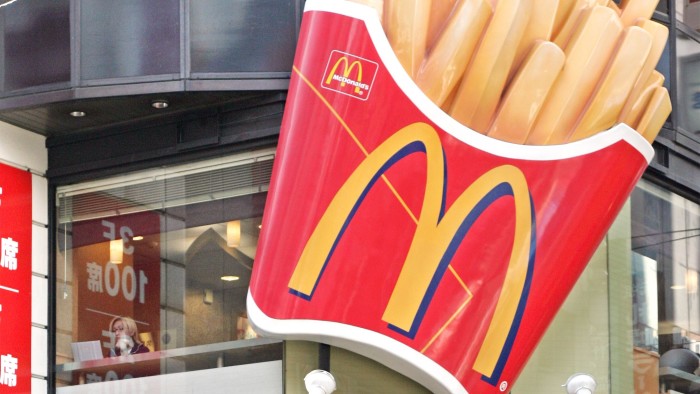McDonald’s all-American menu is shaken by the Shack


Roula Khalaf, Editor of the FT, selects her favourite stories in this weekly newsletter.
This is a tale of two hamburgers. One is in decline and the other is growing. One is a symbol of the US and how it exported fast food to the world. The other is a playful New York City contender, marketed as a healthier, tastier alternative. One is the Big Mac, the other is the ShackBurger.
The Big Mac sells for $4.80, contains 530 calories, and is a familiar pile of mass-produced beef, processed cheese, pickles and bun. A double ShackBurger is “100 per cent all-natural Angus beef. No hormones and no antibiotics ever”, on a potato roll, contains 770 calories and costs $7.99 at the Shake Shack in Madison Square Park.
Which would you prefer?
To judge by the differing fortunes of McDonald’s, which is trying to simplify its overstuffed menu to halt a fall in sales and profits, and Shake Shack, the gourmet burger chain founded by the chef Danny Meyer, which this week filed for an initial public offering, the answer is: the ShackBurger.
Here is another question. Which company is closer to McDonald’s, the self-service stand opened in 1948 in San Bernardino, California by Dick and Mac McDonald, with nine items including a 15-cent hamburger? Is it McDonald’s or Shake Shack, which its IPO filing dubs “a ‘roadside’ burger stand serving a classic American menu of premium burgers, hot dogs, crinkle-cut fries, shakes, frozen custard, beer and wine”?
Perhaps the wine is a giveaway — evidence that Shake Shack is a hipster pastiche, favoured by urban millennials who want their organic beef served with a side of nostalgia, and not a real fast- food joint. Surely McDonald’s, where a Big Mac is relatively expensive and Dollar Menu items such as the Bacon McDouble play the role of the old 15-cent hamburger, is the successor?
But the McDonald brothers served beef without hormones and milkshakes with sugar, not corn syrup. California was fairly natural in 1948. US farm animals were not fed antibiotics until 1951 and beef cattle were not given growth hormones until 1954. The mass use of high fructose corn syrup did not start until the mid-1960s.
What about the price? Fifteen cents is equivalent to $1.47 at today’s prices, closer to the Dollar Menu than either the Big Mac or the ShackBurger. But the US is richer than in 1948 — its gross domestic product per head in 2013 was 3.6 times higher. This suggests the average US consumer can afford $5.29 today as easily as 15 cents in 1948. A single ShackBurger costs $5.19.
Rising disposable income, especially among the well paid and educated, has unleashed a challenge to McDonald’s and other “Quick Service Restaurants” from “fast casual” chains such as Chipotle Mexican Grill, Panera Bread and Noodles & Company. They offer lighter, healthier varieties of food (although a Chipotle burrito often has more calories than a Big Mac).
The young are leaving McDonald’s and Taco Bell for such outlets, and for burger brands such as Shake Shack and Five Guys. They prefer the food, they can afford the prices and they regard McDonald’s as unhealthy, outdated, downmarket and not a nice place to be. In its IPO filing, Shake Shack calls itself “fine casual”, deliberately placing itself at the top of the market.
American fast food is being disrupted from on high, unlike other cases of “disruptive innovation” identified by Clayton Christensen, the Harvard professor. Instead of technology or new business methods allowing entrants to undermine incumbents with cheaper products, McDonald’s has a grip on the mass market but is losing the top.
McDonald’s has long struggled with growing complexity, also known as rising inequality. The McDonald’s stand in 1948, and the franchises later spread across the US by Ray Kroc, were selling to a broad, uniform market. But the top 1 per cent’s share of income in the US has risen from 11 per cent in 1948 to 19 per cent in 2012. Selling one menu to one society is much harder.
Its response has been steadily to add more items to the menu to cover all the bases. The nine items of 1948 have expanded to 121, including 14 desserts and shakes, and 29 kinds of chicken and fish wraps and sandwiches. Its mission statement does not even mention hamburgers. Small wonder that its customers are confused.
It is a very big business, with 35,000 outlets in more than 100 countries and annual revenues of $28bn. Shake Shack is tiny, with 63 Shacks and $82m of sales in 2013. But the upstart sells a lot of ShackBurgers — the average US Shack pulls in $5m a year, twice the revenue of the average US McDonald’s outlet, and is more profitable.
Which would you prefer?
Comments